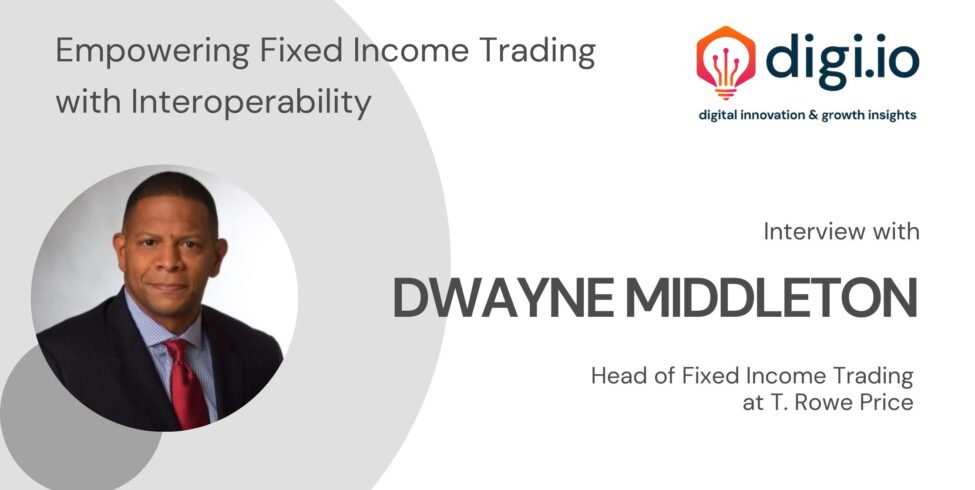Buy-side fixed income traders grapple with a multitude of workflow challenges emerging from a fragmented desktop environment. For November’s digi.io column, Dwayne Middleton, Global Head of Fixed Income Trading at investment management firm T. Rowe Price, explores these challenges, delving into how interop addresses them, as well as its pivotal role in shaping the future of fixed income trading.
Q. What are the challenges posed by the fragmented fixed income desktop environment?
• Data fragmentation: Fixed income traders need to access data from multiple sources and applications. This may present a hindrance to speed in decision-making. Having to toggle between platforms and manually aggregate data is inefficient. Traders need seamless access to data to make quick trading decisions.
• Limited integration: Lack of integration between trading tools and investment applications leads to manual input of data resulting in workflow inefficiency. The disjointed systems require duplicate data entry across platforms, which is error-prone and time-consuming.
• Disparate workflows: Traders may need to switch between different applications, each with a unique workflow leading to a time-consuming trading process. The context switching disrupts workflows and focus. Standardized workflows would optimize trading strategies.
Buy-side fixed income traders face an array of workflow challenges arising from a fragmented desktop environment. With a combination of vendor solutions and internal applications that are disjointed, fixed income traders must open multiple applications and perform manual tasks to source and share information. The constant context switching between applications hampers productivity. Market and internal data are dispersed across various tools and the time inefficiency of pulling data leads to siloed workflows. With the growing pace of fixed income markets, a fragmented desktop creates friction in the order-to-trade life cycle. A unified workspace is needed to improve efficiency.
Q. How do you think interoperability can help solve these issues or inefficiencies?
• Unified workspace: Interoperable workflows provide traders access to market data, risk analytics and trading tools seamlessly. This consolidated view saves time toggling between platforms.
• Efficient data sharing: Interoperability allows for efficiency in data sharing between different applications within the investment process. Portfolio managers, research analysts, and traders all have access to the same information in real-time. This mitigates risk from decisions made on incomplete data.
• Streamlined workflows: Interoperability enables the streamlining of workflows by connecting different stages of the order-to-trade life cycle, from idea generation, liquidity picture, and post-trade analytics. Workflows function seamlessly end-to-end rather than disjointed steps.
Interoperability stands out as a unique solution that may be tailored for each unique investment process at an asset management firm. By creating a unified workspace blending trading insights, portfolio objectives, research insights, and data analytics, our investment platform gains the productivity benefits of an interconnected fixed income technology infrastructure. Modern APIs and cloud technology help reduce constant back-and-forth, minimizing tedious manual tasks. With aggregated data, traders can indulge in comprehensive, real-time monitoring and derive meaningful portfolio insights. Personalized configurations and single sign-on access further boost efficiency. This lays the foundation for scalable straight-through processing across all the trade-execution life cycle.
The robust capability obtained via interoperability positions us to embed future advancements in technology, such as sophisticated data science insights, intelligent automation, and cutting-edge trading tools into our workspace.
Q. What does success look like for interoperability and what benefits do you hope to capture?
• Enhanced decision-making: Achieving success means investment team members make better decisions with robust access to data sets and market insights. With a 360-degree view of all relevant data, decisions will be timely and well-informed.
• Seamless data integration: Data from market data providers, internal applications, composite pricing, and dealer axes/IOIs integrated across a unified workspace. Traders will be better positioned to access this data efficiently and in real-time. There will be no latency in data flows between platforms.
• Enhanced investment platform collaboration: Interoperability should enhance the investment process workflows and strengthen the synergy between fixed income trading, portfolio managers, and research to meet the complexities of client investment objectives. Aligning the incentives and information access between teams will lead to constructive collaboration.
Success with interoperability is multifaceted. I believe it’s about realizing time efficiency of workflow optimization, productivity enhancements, and risk mitigation. Through interoperable workflows, traders will bring informed insights and a broader view of liquidity into the investment discussion via integrated data aggregation tools. The streamlined workflow will benefit portfolio managers and research analysts in making more informed decisions. Quality fixed income traders focus on the capability to bring liquidity information upstream in the investment process. This has the benefit of early visibility into liquidity conditions, which significantly influences decision-making. Building an interoperable workflow is a proactive approach to liquidity management and ensures that investment strategies are formulated with an in-depth understanding of market dynamics, leading to better alignment with real-time market conditions. The value proposition of fixed income trading is maximized within the investment framework through a streamlined data-sharing process.
With interoperability, we build an organic enhanced collaboration between fixed income traders, portfolio managers, and research teams. This synergy fosters a more cohesive assessment of market risk where the insights from each group complement and amplify the others.
Q. Looking ahead, what role will interoperability play in the evolution of fixed income trading?
• Cross-Asset insights: Fixed income traders need the ability to assess multi-sector risk opportunities across cash and derivative instruments. Interoperability provides a consolidated view across asset classes for relative value insights.
• Foundation for innovation: Interoperability enabling the integration of new technologies, real-time analytics, robust set of interchangeable trading protocols. The plug-and-play architecture is future-proof.
• Data literacy: Recognizing and harnessing the power of data to make informed decisions. Interoperability provides the data foundation for advanced analytics and AI to generate alpha.
Interoperability isn’t just about addressing current challenges. I believe it is the catalyst for fixed income trading to navigate the disruption in the evolving fixed income market structure.
The growing need for speed to decision in sourcing liquidity requires a frictionless sharing of information. The fixed income market landscape is becoming increasingly complex, with myriad trading protocols, huge data sets, and tables stakes automation capabilities. This necessitates seamless systems and fluid workflows to be productive.
Trading today isn’t just about executing orders. I believe fixed income trading is an integral part of the broader investment narrative, providing invaluable market insights, timely liquidity data, and execution expertise. Interoperability is beneficial to the trading partnership. The fixed income trader’s role is evolving from simply sourcing liquidity to more of becoming a trading architect. Interoperability will help traders meet the demands of incorporating market acumen, technological insight, and data literacy. The importance of data literacy cannot be overstated as a proficiency in interpreting, analyzing, and applying data to complex trading scenarios. With interoperability, traders can access diverse datasets, and with increased data literacy, they can distill meaningful insights from this information, leading to superior trading decisions. Agility is the mantra that I promote internally. The team’s focus is on adaptability, intelligent risk assessment, and deploying an iterative strategy. Efficiently tapping into liquidity requires immediate access to accurate data, real-time risk analytics, and the agility to pivot based on new insights. Technological advancements are no longer merely supportive trading tools but are becoming central to trading strategies, requiring us to rethink and adapt the way we trade. The potential of AI-driven insights makes the interoperable workspace a need to have versus a nice to have.
For buy-side fixed income traders to efficiently adopt and integrate technology advancements into trading workflows, interoperability is essential. Interoperability in fixed income trading may allow asset managers to create a more cohesive and efficient investment team workflow by reducing data fragmentation, streamlining workflows, automating manual tasks, and improving investment team communication.


